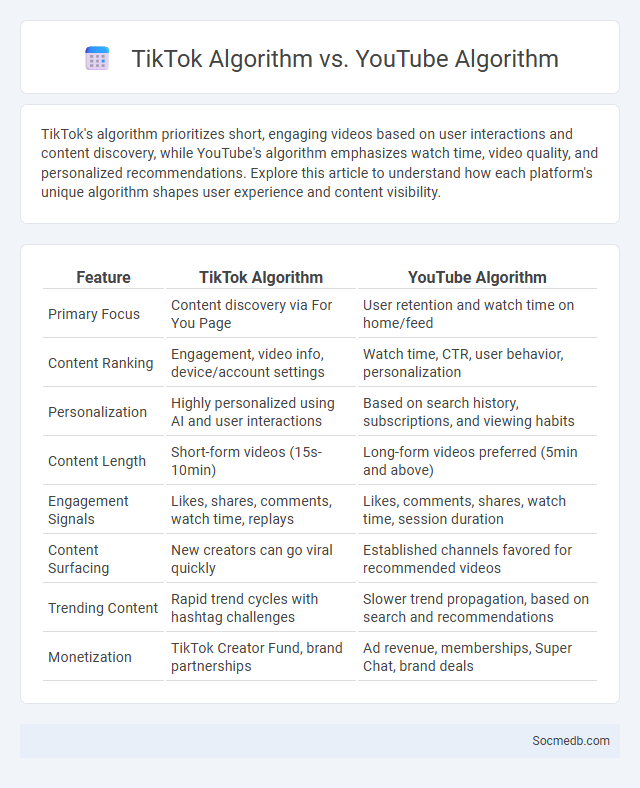
Photo illustration: TikTok Algorithm vs YouTube Algorithm
TikTok's algorithm prioritizes short, engaging videos based on user interactions and content discovery, while YouTube's algorithm emphasizes watch time, video quality, and personalized recommendations. Explore this article to understand how each platform's unique algorithm shapes user experience and content visibility.
Table of Comparison
| Feature | TikTok Algorithm | YouTube Algorithm |
|---|---|---|
| Primary Focus | Content discovery via For You Page | User retention and watch time on home/feed |
| Content Ranking | Engagement, video info, device/account settings | Watch time, CTR, user behavior, personalization |
| Personalization | Highly personalized using AI and user interactions | Based on search history, subscriptions, and viewing habits |
| Content Length | Short-form videos (15s-10min) | Long-form videos preferred (5min and above) |
| Engagement Signals | Likes, shares, comments, watch time, replays | Likes, comments, shares, watch time, session duration |
| Content Surfacing | New creators can go viral quickly | Established channels favored for recommended videos |
| Trending Content | Rapid trend cycles with hashtag challenges | Slower trend propagation, based on search and recommendations |
| Monetization | TikTok Creator Fund, brand partnerships | Ad revenue, memberships, Super Chat, brand deals |
Understanding Social Media Algorithms: TikTok vs YouTube
Social media algorithms on TikTok prioritize content based on user interactions, video information, and device settings, rapidly adapting to individual preferences to maximize engagement. YouTube algorithms analyze watch history, search history, and video performance metrics like click-through rate and watch time to recommend personalized videos. Understanding these platforms' distinct approaches to content curation helps creators tailor their strategies for optimal reach and audience retention.
Core Principles Behind TikTok’s Algorithm
TikTok's algorithm prioritizes user engagement by analyzing watch time, likes, shares, and comments to create a personalized content feed tailored to your interests. It leverages machine learning to continuously refine video recommendations based on your interactions, ensuring relevant and trending content surfaces quickly. The platform also factors in video information and device settings, optimizing content delivery to enhance your overall user experience.
How YouTube’s Recommendation Engine Works
YouTube's recommendation engine operates by analyzing user behavior, including watch history, search queries, and engagement metrics such as likes and comments, to deliver personalized video suggestions. The algorithm employs machine learning techniques and collaborative filtering to predict content that aligns with individual preferences, optimizing user retention and session duration. Continuous feedback loops from real-time interactions enable the system to refine recommendations, enhancing the relevance and diversity of videos shown on the homepage and up next queue.
Key Differences Between TikTok and YouTube Algorithms
TikTok's algorithm prioritizes short-form, engaging videos by analyzing user interactions such as watch time, likes, and shares to deliver highly personalized content on the For You page. YouTube's algorithm emphasizes both viewer retention and search relevance, favoring longer videos that generate sustained watch time, subscriber growth, and CTR through recommendations and search results. While TikTok rapidly surfaces trending content via machine learning for viral potential, YouTube balances content discovery with user preferences and video metadata for long-term engagement.
Factors Influencing Virality on Each Platform
Virality on social media platforms like TikTok, Instagram, and Twitter is influenced by factors such as content relevance, timing, and user engagement metrics including likes, shares, and comments. TikTok's algorithm prioritizes watch time and user interaction to boost viral potential, while Instagram emphasizes hashtags and Stories for content discovery. Twitter's virality often hinges on retweets and trending topics, driven by real-time conversations and influential accounts.
Content Creation Strategies for Beating the Algorithms
Mastering content creation strategies is essential for beating social media algorithms and increasing your reach. Leveraging high-quality visuals, engaging storytelling, and consistent posting schedules improve user interaction rates and signal relevance to platforms. Your focus should include using trending hashtags, interactive polls, and authentic content to boost algorithmic favor and maximize audience engagement.
User Engagement: TikTok vs YouTube
TikTok boasts an average user engagement rate of 5.96%, significantly higher than YouTube's estimated 1.63%, driven by its short-form, algorithmically curated content that encourages quick interaction. YouTube leverages longer-form videos with diverse content types, fostering deeper viewer retention and community building through comments and subscriptions. Both platforms employ unique engagement strategies, yet TikTok's format delivers rapid, repeated user interactions, whereas YouTube emphasizes sustained content consumption and creator-fan relationships.
Algorithm Updates: Staying Ahead of Viral Trends
Social media algorithm updates prioritize content relevance, engagement metrics, and user behavior analysis to curate personalized feeds that boost viral trends. Marketers must monitor platform-specific changes on Facebook, Instagram, TikTok, and Twitter to adapt strategies for maximizing organic reach and visibility. Leveraging real-time data insights and predictive analytics ensures content aligns with evolving algorithms, enhancing virality potential and audience retention.
Case Studies: Viral Success on TikTok and YouTube
Case studies reveal how viral success on TikTok and YouTube is driven by engaging content tailored to platform algorithms that prioritize short, relatable videos and consistent posting schedules. Brands and creators achieve rapid audience growth by leveraging trending challenges, authentic storytelling, and strategic use of hashtags to maximize visibility. Your ability to analyze these patterns and adapt content accordingly can significantly enhance social media impact and follower engagement.
The Future of Algorithm-Driven Virality
Algorithm-driven virality will increasingly rely on advanced machine learning models that analyze user behavior, content preferences, and real-time engagement metrics to optimize content distribution. Platforms like TikTok and Instagram use AI to predict and amplify viral trends, enhancing personalized user experiences and maximizing reach. Emerging innovations in natural language processing and computer vision will further refine algorithm accuracy, shaping the future landscape of social media virality.
 socmedb.com
socmedb.com